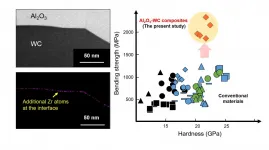Improvements to holographic displays poised to enhance virtual and augmented reality
Advances in both software and hardware could make holography viable for more applications
2021-01-28
(Press-News.org) WASHINGTON -- Researchers have developed a new approach that improves the image quality and contrast for holographic displays. The new technology could help improve near-eye displays used for virtual and augmented reality applications.
"Augmented and virtual reality systems are poised to have a transformative impact on our society by providing a seamless interface between a user and the digital world," said research team member Jonghyun Kim from technology company NVIDIA and Stanford University. "Holographic displays could overcome some of the biggest remaining challenges for these systems by improving the user experience and enabling more compact devices."
In Optica, The Optical Society's (OSA) journal for high impact research, the researchers describe their new holography display technology called Michelson holography. The approach combines a new optical setup inspired by Michelson interferometry with a recent software development. The setup generates the interference patterns necessary for making digital holograms.
"Although we've recently seen tremendous progress in machine-learning driven computer-generated holography, these algorithms are fundamentally limited by the underlying hardware," said Kim. "We co-designed a new hardware configuration and a new algorithm to overcome some of these limitations and demonstrate state-of-the-art results."
Boosting quality
Holographic displays have the potential to outperform other 3D display technologies used for virtual and augmented reality by enabling more compact displays, improving the user's ability to focus their eyes at different distances and offering the ability to adjust for users who wear corrective lenses. However, the technology hasn't yet achieved the image quality of more conventional technologies.
For holographic displays, image quality is limited by an optical component known as a phase-only spatial light modulator (SLM). SLMs create the diffracted light that makes the interference pattern needed to form visible 3D images. However, the phase-only SLMs typically used for holography exhibit a low diffraction efficiency that significantly degrades observed image quality, especially image contrast.
Because it is difficult to dramatically increase the diffraction efficiency of SLMs, the researchers designed a completely new optical architecture to create holographic images. Rather than using a single phase-only SLM like most setups, their Michelson holography approach uses two phase-only SLMs.
"The core idea of Michelson holography is to destructively interfere with the diffracted light of one SLM using the undiffracted light of the other," said Kim. "This allows the undiffracted light to contribute to forming the image rather than creating speckle and other artifacts."
Optimizing the image
The researchers combined this new hardware arrangement with a camera-in-the-loop (CITL) optimization procedure they modified for their optical setup. CITL optimization is a computational approach that can be used to optimize a hologram directly or to train a computer model based on a neural network.
CITL allowed the researchers to use a camera to capture a series of displayed images. This meant they could correct small misalignments of the optical system without using any precise measuring devices.
"Once the computer model is trained, it can be used to precisely figure out what a captured image would look like without physically capturing it," said Kim. "This means that the entire optical setup can be simulated in the cloud to perform real-time inference of computationally heavy problems with parallel computing. This could be useful for calculating a computer-generated hologram for a complicated 3D scene, for example."
The researchers tested their new Michelson holography architecture using a benchtop optical setup in their lab. They used it to display several 2D and 3D holographic images, which were recorded with a conventional camera. The demonstration showed that the dual-SLM holographic display with CITL calibration provides significantly better image quality than existing computer-generated hologram approaches.
Making the new system practical would require translating the benchtop setup into a system that would be small enough to incorporate into a wearable augmented or virtual reality system. The researchers point out that their approach of co-designing hardware and software could be useful for improving other applications of computational displays and computational imaging in general.
INFORMATION:
Paper: S. Choi, J. Kim, Y. Peng, G. Wetzstein, "Michelson Holography: Dual-SLM Holography with Camera-in-the-loop Optimization," Optica, 8, 1, 143-146 (2021).
DOI: https://doi.org/10.1364/OPTICA.410622.
About Optica
Optica is an open-access, journal dedicated to the rapid dissemination of high-impact peer-reviewed research across the entire spectrum of optics and photonics. Published monthly by The Optical Society (OSA), Optica provides a forum for pioneering research to be swiftly accessed by the international community, whether that research is theoretical or experimental, fundamental or applied. Optica maintains a distinguished editorial board of more than 60 associate editors from around the world and is overseen by Editor-in-Chief Prem Kumar, Northwestern University, USA. For more information, visit Optica.
About The Optical Society
Founded in 1916, The Optical Society (OSA) is the leading professional organization for scientists, engineers, students and business leaders who fuel discoveries, shape real-life applications and accelerate achievements in the science of light. Through world-renowned publications, meetings and membership initiatives, OSA provides quality research, inspired interactions and dedicated resources for its extensive global network of optics and photonics experts. For more information, visit osa.org.
Media Contacts:
Aaron Cohen
(301) 633-6773
aaroncohenpr@gmail.com
mediarelations@osa.org
ELSE PRESS RELEASES FROM THIS DATE:
2021-01-28
(Singapore--January 28, 2021 11:00 p.m. SPT/10:00 a.m. EST)----Several leading international lung cancer researchers at a press briefing held by the International Association for the Study of Lung Cancer today, presented compelling new data revealing that factors of race, gender, sexual orientation and income continue to be significant barriers to those living with lung cancer. The press briefing is part of the IASLC's World Conference on Lung Cancer 2020 Singapore.
The press briefing is moderated by IASLC Communications Committee Chair Dr. Anne-Marie Baird, senior research fellow at Trinity College in ...
2021-01-28
Clear rules for engineering transgenes that can be inserted and propagated over multiple generations of nematodes include ways to protect inserted genes from the organism's natural defenses against foreign DNA. Developed by KAUST researchers, the rules have implications for many research fields, including gene therapy development.
Scientists often study biological processes, such as normal and mutant gene functions, in the worm Caenorhabditis elegans because it has many genes and molecular pathways in common with humans. Specific gene functions can be investigated by injecting DNA into the worm's reproductive organs, where it links into what is known as an extra-chromosomal array. This array is eventually incorporated into the nucleus, where it is duplicated ...
2021-01-28
A team led by Prof. SU Bing from the Kunming Institute of Zoology (KIZ) of the Chinese Academy of Sciences (CAS), Prof. LI Cheng from Peking University, and Prof. ZHANG Shihua from the Academy of Mathematics and Systems Science of CAS has reported the highest resolution by far of the 3D genome of the primate brain, and demonstrated the molecular regulatory mechanisms of human brain evolution through cross-species multi-omics analysis and experimental validation. The study was published in Cell.
The unique pattern of human brain development stems from accumulated genetic changes during human evolution. Among the huge number of diverging genetic changes, only a small portion of the between-species ...
2021-01-28
Studying the creation and evolution of sulfur-containing compounds in outer space is essential for understanding interstellar chemistry. CS2 is believed to be the most important molecule in comet nuclei, interstellar dust, or ice cores. CS and S2 are the photodissociation fragments of CS2.
Forty years ago, the emission spectra of only CS and S2 species, and not those of CS2 species, were observed from several comets by the International Ultraviolet Explorer satellite. The photodissociation mechanism of CS2 molecules remains unclear, and S2 fragments have not been experimentally observed before.
Recently, a team led by Prof. YUAN Kaijun from the Dalian Institute of Chemical Physics (DICP) of the Chinese Academy of Sciences (CAS), in cooperation with Prof. WANG Xing'an's group ...
2021-01-28
An ecologist from RUDN University together with colleagues from 14 countries compared three methods for estimating ecosystem transpiration in a study. In the first ever research with such a comprehensive data-set, the team used land-atmosphere water vapor flux data of collected at 251 locations all over the planet, from Australia to Greenland. The outcome of the research help to understand the role of plants in the global water and carbon cycles in the current predicament of global warming. The results of the study were published in the December 2020 issue of the journal Global ...
2021-01-28
Western Carolina University researchers find a disproportionate number of inmates with violent offenses suffer from post-traumatic stress disorder, panic disorder and alcohol use disorder, and published their findings in the Journal of Criminal Psychology.
Alexa Barrett, clinical psychology master's student at WCU, and Al Kopak, associate professor of criminology and criminal justice at WCU, discovered the combination of PTSD, PD and AUD significantly increased the likelihood of violent offenses while conducting research at three county detention centers in North Carolina.
Supported by a Summer Research Assistantship provided by the Graduate School, the purpose of this study was to detail ...
2021-01-28
A PhD student and 'beer scientist' has inadvertently discovered a way to conduct extremely small-scale brewing experiments, potentially leading to better beer.
It came about when University of Queensland PhD candidate Edward Kerr hit a hurdle when he completed a beer brewing experiment for a paper.
"I was looking at barley protein changes during the mashing stage of beer brewing, when one of the paper's reviewers asked if the changes were caused by temperature or time spent mashing the barley," Mr Kerr said.
"It was a good question, but to find out I'd need to brew all over again, with an instrument that would hold at least 23 litres ...
2021-01-28
WASHINGTON, D.C. and SAN DIEGO, CA -- In his inaugural address, President Joe Biden vowed that "help is on the way" to a nation grappling with a pandemic that has already claimed over 420,000 lives and counting. However, despite the promise of a better future, a new survey from West Health and Gallup finds Americans remain largely skeptical that issues as varied as managing the COVID-19 crisis, lowering healthcare costs, improving the economy, fixing immigration and addressing climate change, will improve anytime soon.
The findings from the monthly West Health-Gallup U.S. Healthcare Study are based on a ...
2021-01-28
Pioneering research into how our bodies manufacture the cells that make blood has moved us closer to regrowing tissues and organs. The findings also may let doctors grow the cells for transplantation into people to battle cancer, blood disorders and autoimmune diseases.
Researcher Karen K. Hirschi, PhD, of the Department of Cell Biology and the Robert M. Berne Cardiovascular Research Center at the University of Virginia School of Medicine, has developed a simple and efficient way to generate "hemogenic endothelial cells." These cells are the first step in the production line of blood cells, and Hirschi's new findings provide a blueprint for creating them outside the body.
"By studying how hemogenic endothelial cells develop normally, we gain insights needed ...
2021-01-28
Ceramic matrix composites (CMCs) are incredibly strong materials used in jet engines, gas turbines, and cutting tools for nickel superalloys. Aluminum oxide (Al2O3) is hard and chemically inert, and tungsten carbide (WC) is used as a superhard material, but past efforts to create an Al2O3-WC CMC yielded unsatisfactory results. Recently, a study by Japanese scientists, published in Scientific Reports, shows that adding zirconium atoms results in improved Al2O3-WC CMCs.
Given the potential utility of Al2O3-WC CMCs as superhard materials, researchers around the world have tested several formulations to identify one with a high bending strength, which is a measure of the physical stress a material can be subjected to before it becomes permanently bent or broken. Previously, ...
LAST 30 PRESS RELEASES:
[Press-News.org] Improvements to holographic displays poised to enhance virtual and augmented reality
Advances in both software and hardware could make holography viable for more applications







